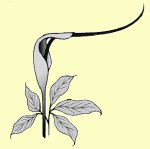
Arisaema dracontium
(green dragon, dragon root)
Home page
Articles
|

Skyrockets and shooting
stars
by Bill Plummer
Scheduled to arrive in Eugene at 12:40 in time for the 2:00 NARGS Board Meeting on a direct flight from Detroit to Portland, I discovered the day before that that flight had been eliminated and that I would be arriving several hours later being routed through Minneapolis and St. Paul. That was the only hitch in a wonderful weekend other than not getting to Quaking Aspen bog to see the other half of the meeting title. More about that later.
Opening night speakers were two of the Emerald Chapter's own - Louise Parsons, co-listowner of
Alpine-L, geologist, surveyor and gardener with a learned lecture entitled "Lava, Lichens and Lithophiles" and Loren Russell. Loren is one of the better known and more knowledgeable correspondents on Alpine-L who shared with us his frequent treks "Above and Beyond the Western Cascades".
Harold McBride was the featured speaker on both Thursday and Friday evenings speaking on "Alpines in Cultivation and Natural Habitat in Ireland" and "Plants for the Peat Bed and Woodland Gardens". Harold is a superb plantsman - demonstrated by his gardens and the plants he grows, an excellent photographer - whose slides spoke for themselves, and an entertaining and informative speaker - presenting excellent and charming lectures. (I also had the pleasure of hearing Harold at "Southern Alpines, 96"). Harold had a second screen listing the Latin names of the plants being shown. The Banquet Speaker was Alfred Ceska who gave a humorous, tongue-in-cheek talk, entitled, "New Advances in the Study of Spinach and Civilization".
On Sunday morning another stalwart of the chapter, Ernie O/Byrne described the construction of the Sebring Rock Garden developed with funds from NARGS and with the cooperation and help from the Eugene Parks Department. A major flood swept through washing away the tons of soil necessitating starting all over. Completed just this spring it was the first stop on our bus tour of Eugene gardens - a remarkable achievement which will only become more remarkable as it matures..
I requested "moderate" field trips and the two trips were listed as "easy to moderate". I opted for the "fast" group. Iron Mountain at 5455 feet (rising 850 feet in a mile) and Olallie Ridge: Horsepasture Mountain at 5660 feet (a two mile hike to the summit) were a bit of a challenge for this septuagenarian. But well worth the huffing and puffing and the sweat. We were provided with a Checklist booklet of Western Cascade plants which listed the plants reported from all five sites of the field trips. We were also given the opportunity to purchase at a steep discount (subsidized by the Emerald Chapter) of Robert Ross and Henrietta Chambers, "Wildflowers of the Western Cascades".
On our field trip to Iron Mountain we first stopped at a falls near the headwaters of the McKenzie River - a rainforest with moss everywhere and a nice colony of Linnae borealis. On Iron Mountain particularly impressive was
Gilia aggregata (skyrocket), Calchortus subalpinus and Penstemmon rupicola. Along the way there would be drifts of blue
Delphinium menzeisii, red Castilleja miniata and mustard-yellow
Mimulus breweri. The views back through the low-lying clouds and those from the summit were stunning.
The trek up to the summit of Horse Pasture Mountain first led through a forest with huge sweeps of
Achlys triphylla (Vanilla leaf) and Cornus canadensis. We leave the forest and continue up to the summit where around the old cabin site were German Iris. We stayed at the top for some time just admiring the natural rock garden with myriad clumps of
Penstemmon rupicola and nestled in a crack a magnificent plant of Cheilanthes gracillima.
Coming back down I had to stop and take slides of those stands of Vanilla leaf and bunchberry. On both mountains there were huge clumps of vigorous plants of our familiar,
Smilacina racemosa and on Iron Mountain its smaller cousin, S. stellata. We never saw large clumps of
Xerophyllum tenax (beargrass), but what we saw was impressive. Then it was on to Quaking Aspen Swamp an area which was denied the previous day's members because of the dense fog. The guide of the "fast" group took off with none of us looking eight feet above to see the trail sign that this was not the trail to the swamp. But we plunged blindly on until an hour and miles later our leader finally came to the conclusion that we were not headed for the swamp. Consequently we did not see the other half of the meeting theme,
Dodecatheon jeffreyi.
Web design and maintenance by Craig
Cramer, cdcramer@twcny.rr.com
|

